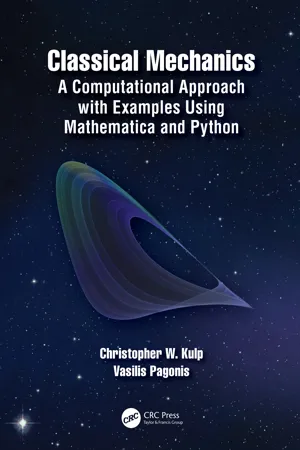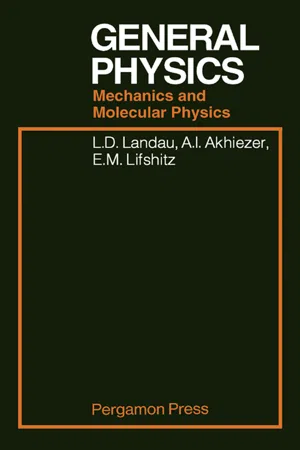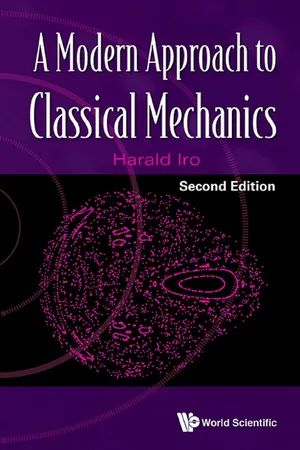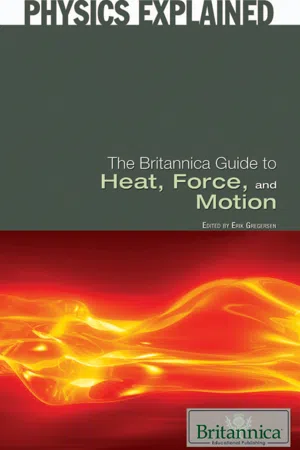Mathematics
Particle Model Motion
The particle model of motion is a simplified representation of motion that treats objects as if they were point particles with mass but no size. It is used to study the motion of objects in physics and engineering, and it helps to simplify complex systems by focusing on the motion of individual particles. This model is often used to analyze the behavior of objects in various physical scenarios.
Written by Perlego with AI-assistance
Related key terms
5 Key excerpts on "Particle Model Motion"
- eBook - ePub
- A. L. Stanford, J. M. Tanner(Authors)
- 2014(Publication Date)
- Academic Press(Publisher)
translational motion is being considered, that is, when any vibrations or rotations of the body are of no consequence to the problem at hand. Large or small bodies may be treated as particles. The earth in its orbit or an automobile moving along a highway may each be thought of as a particle provided we are interested in its translational motion only. Thus, in describing translational motion of physical bodies, we may use the model of a point particle. In this chapter, we shall consider the kinematics of particles.To be physically meaningful a description of motion must be measurable relative to some frame of reference, such as a coordinate system that could be established within a laboratory. With this in mind, a description of the motion of a particle at a given instant should answer the following questions:1. Where is the particle relative to a chosen reference frame? 2. How fast is the particle moving, and in what direction is it moving? 3. To what extent and in which direction is its motion changing? In this chapter we shall consider how these questions may be answered quantitatively and how the answers are interpreted and applied.2.1 Motion Along a Straight Line (Rectilinear Motion)
Position, Velocity, and Acceleration
Perhaps the simplest example of kinematics is the motion of a particle constrained to move along a straight line. Suppose such a particle is moving along the x axis, as shown in Figure 2.1 . In Figure 2.1(a) the position of the particle is specified by a position vector r , a vector that originates at the coordinate origin and terminates at the particle P . As the particle moves, the vector r changes, so r is a function of time and may be written as r (t ) to emphasize its dependence on time. Then for this one-dimensional case, the position vector r is specified byFigure 2.1 (a ) The position vector r locating a particle P lying on the axis. (b ) The instantaneous velocity vector v for a particle P moving along the x - eBook - ePub
Classical Mechanics
A Computational Approach with Examples Using Mathematica and Python
- Christopher W. Kulp, Vasilis Pagonis(Authors)
- 2020(Publication Date)
- CRC Press(Publisher)
CHAPTER 2Single-Particle Motion in One DimensionIn this chapter, we will examine one-dimensional motion, i.e., motion along a line. It is sometimes the case that a particle’s motion need only to be described along one direction. Furthermore, a careful study of one-dimensional motion will be a useful foundation for understanding more general motion in higher dimensions. In this chapter, we will give several examples of solving Newton’s second law, F = ma in one dimension. We will consider several types of forces: both constant and those which depend on time F(t), velocity F(v), and position F(x). In addition, we will discuss and demonstrate two different uses of computers to solve physics problems: how to use computer algebra systems (CAS) to obtain the analytical solutions of Newton’s second law, and how to obtain numerical solutions of ordinary differential equations (ODE) using software packages and by using the Euler method.2.1Equations of motionTo begin our study of one-dimesional motion, we first need to make some assumptions about the object whose motion we are examining. One fundamental assumption in this chapter is that the object being studied is a point particle. In order to mathematically describe the motion of a particle under the influence of a force, we need to find the particle’s equations of motion. The equations of motion of a particle are the equations which describe its position, velocity, and acceleration as a functions of time. Equations of motion can be in the form of algebraic equations, or in the form of differential equations.As we will see, the equations of motion of a particle can be found by solving Newton’s second law as a differential equation. In this chapter, we will focus on one-dimensional motion, where the force vector and the particle’s displacement are along the same line (but not necessarily in the same direction—the direction could be horizontal or vertical). Because all vectors in a given problem lay along the same line, we drop the vector notation in all the equations. A negative sign between two quantities will denote vectors that lay in opposite directions along the same line. - eBook - ePub
General Physics
Mechanics and Molecular Physics
- L D Landau(Author)
- 2013(Publication Date)
- Pergamon(Publisher)
CHAPTER I PARTICLE MECHANICS Publisher Summary The fundamental concept of mechanics is that of motion of a body with respect to other bodies. The relativity of motion arises from the relativity of the concept of space itself. This chapter discusses the principle of the relativity of motion. It is reasonable to begin the study of the laws of motion by considering the motion of a body of small dimensions. The motion of such a body is especially simple because there is no need to take into account the rotation of the body or the relative movement of different parts of the body. A body whose size may be neglected in considering its motion is called a particle and is a fundamental object of study in mechanics. The possibility of treating the motion of a given body as that of a particle depends not only on its absolute size but also on the conditions of the physical problem concerned. The position of a particle in space is defined by specifying three coordinates, for instance, the three Cartesian coordinates x, y, z. For this reason, a particle is said to have three degrees of freedom. The motion of a particle is described by its velocity. The chapter also discusses momentum, motion under reactive forces, centre of mass, acceleration, force, dimensions of physical quantities, motion in a uniform field, work and potential energy, the law of conservation of energy, internal energy, boundaries of the motion, elastic collisions, and angular momentum. Besides energy and momentum, another vector quantity called angular momentum is conserved for any closed system. This quantity is the sum of the angular momenta of the individual particles - eBook - ePub
- Harald Iro(Author)
- 2015(Publication Date)
- WSPC(Publisher)
3One-dimensional motion of a particle
The simplest system consists of a single particle whose motion only has one degree of freedom. In the following, we investigate the constants of the motion and the conserved quantities for Newton’s equation in one dimension. Since the representation in phase space here is two-dimensional, the particle’s motion in phase space can be visualized graphically.3.1 Examples of one-dimensional motion
Figure 3.1: The inclined track.i) The inclined track: A particle of mass m slides without friction on a track inclined at angle α to the direction of the gravitational force F = mg. Since forces obey vector addition (see Page 17), the force of gravity can be split into components parallel and perpendicular to the track1 :where (see Fig. 3.1 )Motion along the track is influenced only by F|| ; the perpendicular component F is exactly counterbalanced by the track2 (see Fig. 3.1 ). Let s be the distance along the track (with respect to some initial point s0 = 0). The momentum of the particle is p = m . Hence, the equation of motion isFigure 3.2: The plane pendulum.Figure 3.3: An oscillating mass.ii) The plane mathematical pendulum: A particle of mass m is attached to the end of a massless bar of length l that can swing freely about a fixed point. The particle is pushed such that its motion always remains in the plane (i.e. the initial velocity vector lies in the plane containing the bar and gravitational force vector). Since lϕ is the arclength, where ϕ is the angle between the bar and the vertical, the equation of motion reads (see also Section 3.3.2 below):iii) The harmonic oscillator: A particle of mass m is confined to move along the x-axis. It is attached to a spring, with equilibrium position xequ. Assume that the spring obeys Hooke’s Law, |F| ∝ |x − xequ|, meaning that the force is harmonic, i.e. it is given by F = −k(x − xequ). If xequis chosen as the origin, i.e. xequ - eBook - ePub
- Britannica Educational Publishing, Erik Gregersen(Authors)
- 2010(Publication Date)
- Britannica Educational Publishing(Publisher)
Resonances are not uncommon in the world of familiar experience. For example, cars often rattle at certain engine speeds, and windows sometimes rattle when an airplane flies by. Resonance is particularly important in music. For example, the sound box of a violin does its job well if it has a natural frequency of oscillation that responds resonantly to each musical note. Very strong resonances to certain notes—called “wolf notes” by musicians—occur in cheap violins and are much to be avoided. Sometimes, a glass may be broken by a singer as a result of its resonant response to a particular musical note.MOTION OF A PARTICLE IN TWO OR MORE DIMENSIONS
More complex problems in mechanics involve a particle moving in two or more dimensions. Such problems include those of the pendulum and the circular orbit.PROJECTILE MOTIONGalileo pointed out with some detectable pride that none before him had realized that the curved path followed by a missile or projectile is a parabola. He had arrived at his conclusion by realizing that a body undergoing ballistic motion executes, quite independently, the motion of a freely falling body in the vertical direction and inertial motion in the horizontal direction. These considerations, and terms such as ballistic and projectile, apply to a body that, once launched, is acted upon by no force other than Earth’s gravity.Projectile motion may be thought of as an example of motion in space—that is to say, of three-dimensional motion rather than motion along a line, or one-dimensional motion. In a suitably defined system of Cartesian coordinates, the position of the projectile at any instant may be specified by giving the values of its three coordinates, x (t ), y (t ), and z (t ). By generally accepted convention, z (t ) is used to describe the vertical direction. To a very good approximation, the motion is confined to a single vertical plane, so that for any single projectile it is possible to choose a coordinate system such that the motion is two-dimensional [say, x (t ) and z (t )] rather than three-dimensional [x (t ), y (t ), and z (t
Index pages curate the most relevant extracts from our library of academic textbooks. They’ve been created using an in-house natural language model (NLM), each adding context and meaning to key research topics.




